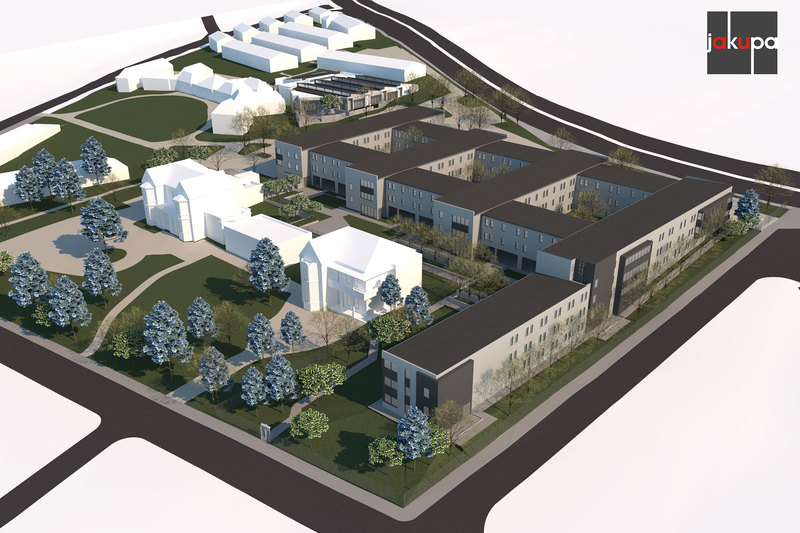First SA student residence to get Green Star rating
31 August 2020 | Story Helen Swingler. Photo Supplied. Voice Neliswa Sosibo. Read time 8 min.
With its water and energy savings and full suite of disability features, the University of Cape Town’s (UCT) new 500-bed Avenue Road Residence is the first South African student housing development to be awarded a Green Star rating from the Green Building Council South Africa (GBCSA). The project achieved a four-star rating.
The GBCSA promotes sustainable development and property industry transformation through green-building programmes, third-party certification, events, training, technologies and design practices. The Green Star rating is a holistic green-building tool that focuses on various aspects, including energy, embodied energy, carbon emissions, water, healthy spaces for people, ecology, transport and construction management.
This South African ‘first’ represents a proud achievement for the university in its drive to become more sustainable, said UCT’s director of environmental sustainability, Manfred Braune.
The R222 million development in Mowbray was co-funded by the Department of Higher Education and Training, with R130 million coming from UCT. The three-storey residence has 144 single rooms and 173 double rooms; six of these will offer en-suite assisted living facilities for students with disabilities.
“UCT aims in the long term to have at least one third of its students housed in its own student housing facilities to support the needs of many poor South African students.”
As most water and energy usage comes from the university’s residences, the infrastructure will include a partial grey-water system and heat pumps. Fittings will include water-saving toilets and energy-efficient lighting. There is also a borehole on site, which in a drought scenario (and depending on water quality) will allow the building to continue to operate by using groundwater. Under normal conditions it could revert to municipal supply.
Construction and fit-out will be completed towards the end of 2020. The residence will open for the 2021 academic year, easing the growing pressure on student housing at UCT as the student population gradually grows to 32 000 – the target growth trajectory for its land-locked campuses.
“UCT aims in the long term to have at least one third of its students housed in its own student housing facilities to support the needs of many poor South African students who cannot realistically study from home,” said architect and urban planner Nigel Haupt, the director of the university’s Capital Planning and Projects unit.
Rigorous evaluation
To qualify for a Green Star rating, buildings are evaluated across nine main categories:
- management
- indoor environment quality
- energy
- transport
- water
- materials
- land use and ecology
- emissions
- innovation.
Each category addresses specific green-building criteria. Credits in each category are awarded points, which are assessed for the final score. Weighting factors reflect the specific environmental concerns in the different building sectors.
Braune commended Haupt and his project team in the Properties and Services department, Grant Willis and Glenn von Zeil and the student housing team, and the design and construction team, led by the Eris Property Group, for the achievement, “especially on a project that has tested a new form of turnkey development for UCT”.
He added: “By having the design assessed by the GBCSA, it creates transparency and accountability of the design and construction teams to ensure that the building is greener and more energy efficient than what is required by national code, independently verifying the project’s green credentials.”
Setting the tone for future students
Dacre Hattingh, a UCT alumnus and the development manager of the Eris Property Group, added: “The project represents an incredible milestone for the company as a leader in student accommodation space.”
Included in their achievements is the development of the Cape Town foreshore’s Portside building, the first high-rise five-star Green Star-rated building in Africa.
Of the Avenue Road Residence he said: “From the design phase through to planning and construction, the core focus was to ensure that the residence placed equal importance on offering a home for future generations, while taking care of the environment.”
“This certification is particularly exciting as it is the first Green Star student residence that has been rated in the country.”
Georgina Smit, the head of technical services for the GBCSA, said: “This certification is particularly exciting as it is the first Green Star student residence that has been rated in the country. Green buildings such as UCT’s Avenue Road Residence enable our bright young minds to learn and live in spaces that contribute to better health, reduced environmental impact and an awareness of sustainability.”
The project used a custom-tool approach to adapt the Green Star new-build tools for a student residence context.
Alison Groves, the regional director of WSP, specialist consultants in sustainable buildings, said that while some constructions offer sustainable elements, a Green Star rating is the country’s most comprehensive measure of sustainability.
“Besides elements such as water and energy, Green Star looks at indoor environmental quality, which is a very important part of living space, as well as materials that reduce embodied carbon associated with building materials.”
They also consider aspects such as placement: How well has the building been placed in its location? Does it have good access to public transport to reduce private vehicle use? Are there cycling facilities that provide a non-carbon form of transport?
Landscaping that enhances biodiversity and incorporates indigenous and waterwise planting is another key element, Groves said.
“But if it isn’t meeting the needs of the people who use it, and if they don’t love the building and feel at home and comfortable in it, it would not have achieved its objective. So, it’s very important to include the aspect of how the people use the building as part of the sustainability measure.”
Gate-opener tool
Groves said that the GBCSA’s custom tool, which merged the features of building tools from both the public and education sectors, created a “very robust way” of reviewing the building.
“This has been a gate opener; it will open the way for others to pursue student residence ratings using Green Star.”
“This has been a gate opener; it will open the way for others to pursue student residence ratings using Green Star.”
But there are other benefits to Green Star ratings for universities, Groves added. Funding new developments requires careful consideration of what and where money is invested. To align the ‘people, planet and profit’ business considerations, she said, investors and financiers not only want to know that the environment is being protected, but also that significant operational costs are being saved with a good return on investment.
“In terms of sustainable investment, Green Star-rated buildings should perform better … And then there’s the focus on people and measuring their levels of comfort. There’s a lot of goodwill associated with being in a sustainable building and that is a driver in itself; people want to be associated with a greener economy.”
 This work is licensed under a Creative Commons Attribution-NoDerivatives 4.0 International License.
This work is licensed under a Creative Commons Attribution-NoDerivatives 4.0 International License.
Please view the republishing articles page for more information.
Listen to the news
The stories in this selection include an audio recording for your listening convenience.























































































































































































































































































































































































